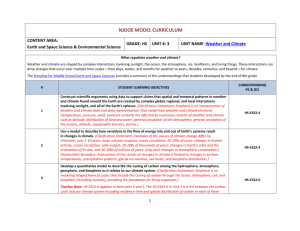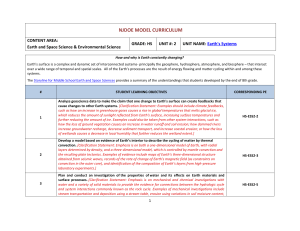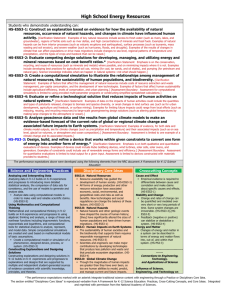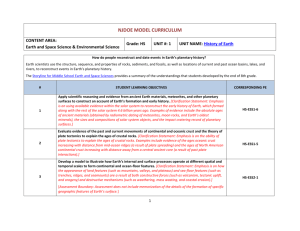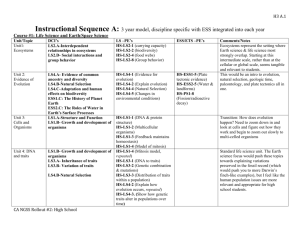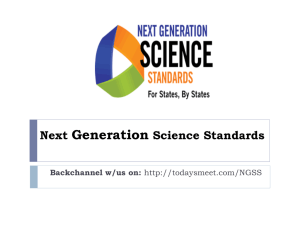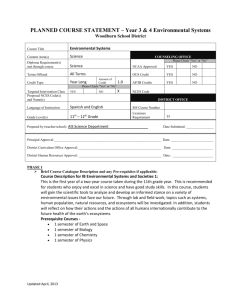Word - State of New Jersey
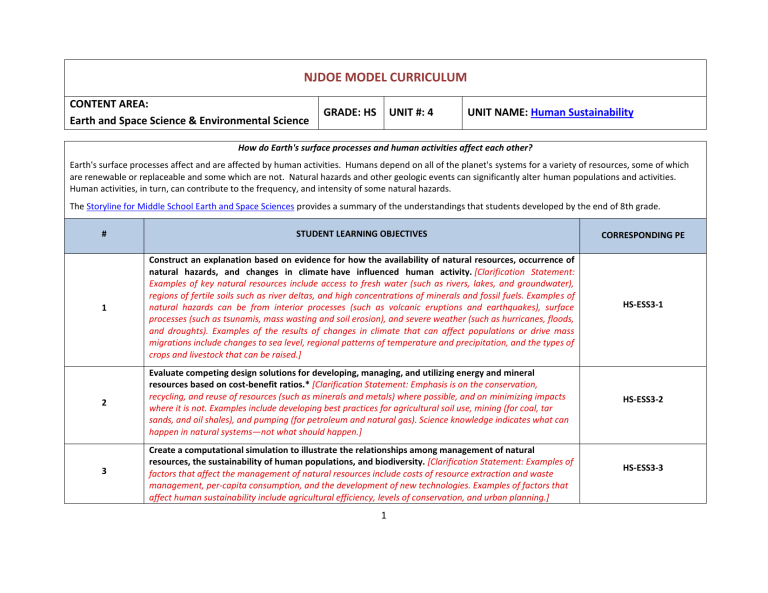
NJDOE MODEL CURRICULUM
CONTENT AREA:
Earth and Space Science & Environmental Science
GRADE: HS UNIT #: 4 UNIT NAME: Human Sustainability
How do Earth's surface processes and human activities affect each other?
Earth's surface processes affect and are affected by human activities. Humans depend on all of the planet's systems for a variety of resources, some of which are renewable or replaceable and some which are not. Natural hazards and other geologic events can significantly alter human populations and activities.
Human activities, in turn, can contribute to the frequency, and intensity of some natural hazards.
The Storyline for Middle School Earth and Space Sciences provides a summary of the understandings that students developed by the end of 8th grade.
#
1
2
3
STUDENT LEARNING OBJECTIVES
Construct an explanation based on evidence for how the availability of natural resources, occurrence of natural hazards, and changes in climate have influenced human activity. [Clarification Statement:
Examples of key natural resources include access to fresh water (such as rivers, lakes, and groundwater), regions of fertile soils such as river deltas, and high concentrations of minerals and fossil fuels. Examples of natural hazards can be from interior processes (such as volcanic eruptions and earthquakes), surface processes (such as tsunamis, mass wasting and soil erosion), and severe weather (such as hurricanes, floods, and droughts). Examples of the results of changes in climate that can affect populations or drive mass migrations include changes to sea level, regional patterns of temperature and precipitation, and the types of crops and livestock that can be raised.]
Evaluate competing design solutions for developing, managing, and utilizing energy and mineral resources based on cost-benefit ratios.* [Clarification Statement: Emphasis is on the conservation, recycling, and reuse of resources (such as minerals and metals) where possible, and on minimizing impacts where it is not. Examples include developing best practices for agricultural soil use, mining (for coal, tar sands, and oil shales), and pumping (for petroleum and natural gas). Science knowledge indicates what can happen in natural systems—not what should happen.]
Create a computational simulation to illustrate the relationships among management of natural resources, the sustainability of human populations, and biodiversity. [Clarification Statement: Examples of factors that affect the management of natural resources include costs of resource extraction and waste management, per-capita consumption, and the development of new technologies. Examples of factors that affect human sustainability include agricultural efficiency, levels of conservation, and urban planning.]
1
CORRESPONDING PE
HS-ESS3-1
HS-ESS3-2
HS-ESS3-3
NJDOE MODEL CURRICULUM
CONTENT AREA:
Earth and Space Science & Environmental Science
GRADE: HS UNIT #: 4 UNIT NAME: Human Sustainability
4
5
[Assessment Boundary: Assessment for computational simulations is limited to using provided multiparameter programs or constructing simplified spreadsheet calculations.]
Evaluate or refine a technological solution that reduces impacts of human activities on natural systems.*
[Clarification Statement: Examples of data on the impacts of human activities could include the quantities and types of pollutants released, changes to biomass and species diversity, or areal changes in land surface use (such as for urban development, agriculture and livestock, or surface mining). Examples for limiting future impacts could range from local efforts (such as reducing, reusing, and recycling resources) to largescale geoengineering design solutions (such as altering global temperatures by making large changes to the atmosphere or ocean).]
Use a computational representation to illustrate the relationships among Earth systems and how those relationships are being modified due to human activity. [Clarification Statement: Examples of Earth systems to be considered are the hydrosphere, atmosphere, cryosphere, geosphere, and/or biosphere. An example of the far-reaching impacts from a human activity is how an increase in atmospheric carbon dioxide results in an increase in photosynthetic biomass on land and an increase in ocean acidification, with
resulting impacts on sea organism health and marine populations.] [Assessment Boundary: Assessment does not include running computational representations but is limited to using the published results of scientific computational models.]
HS-ESS3-4
HS-ESS3-6
2
NJDOE MODEL CURRICULUM
CONTENT AREA:
Earth and Space Science & Environmental Science
GRADE: HS UNIT #: 4 UNIT NAME: Human Sustainability
The performance expectations above were developed using the following elements from the NRC document A Framework for K-12 Science Education:
Science and Engineering Practices
Using Mathematics and Computational
Thinking (pp. 64-67)
Students use algebraic thinking and analysis, a range of linear and nonlinear functions including trigonometric functions, exponentials and logarithms, and computational tools for statistical analysis to analyze, represent, and model data. Simple computational simulations are created and used based on mathematical models of basic assumptions.
Create a computational model or simulation of a phenomenon, designed device, process, or system. (HS-ESS3-3)
Use a computational representation of phenomena or design solutions to describe and/or support claims and/or explanations.
(HS-ESS3-6)
Constructing Explanations and Designing
Solutions (pp. 67-71)
Students construct explanations and design solutions that are supported by multiple and independent student-generated sources of evidence consistent with scientific knowledge, principles, and theories.
Construct an explanation based on valid and
Disciplinary Core Ideas
ESS2.D: Weather and Climate (pp. 186-189)
Current models predict that, although future regional climate changes will be complex and varied, average global temperatures will continue to rise. The outcomes predicted by global climate models strongly depend on the amounts of human-generated greenhouse gases added to the atmosphere each year and by the ways in which these gases are absorbed by the ocean and biosphere. (secondary to HS-ESS3-6)
ESS3.A: Natural Resources (pp. 191-192)
Resource availability has guided the development of human society. (HS-ESS3-1)
All forms of energy production and other resource extraction have associated economic, social, environmental, and geopolitical costs and risks as well as benefits. New technologies and social regulations can change the balance of these factors. (HS-ESS3-2)
ESS3.B: Natural Hazards (pp. 192-194)
Natural hazards and other geologic events have shaped the course of human history; [they] have significantly altered the sizes of human populations and have driven human migrations.
Crosscutting Concepts
Cause and Effect (pp. 87-89)
Empirical evidence is required to differentiate between cause and correlation and make claims about specific causes and effects. (HS-ESS3- 1)
Systems and System Models (pp. 91-94)
When investigating or describing a system, the boundaries and initial conditions of the system need to be defined and their inputs and outputs analyzed and described using models. (HS-ESS3-6)
Stability and Change (pp. 98-101)
Change and rates of change can be quantified and modeled over very short or very long periods of time. Some system changes are irreversible. (HS-
ESS3-3)
Feedback (negative or positive) can stabilize or destabilize a system. (HS-ESS3-4)
- - - - - - - - - - - - - - - - - - - - - - - - - - - - - - - - - - -
Connections to Engineering, Technology,
and Applications of Science
Influence of Science, Engineering, and Technology on Society and the Natural World
Modern civilization depends on major
3
NJDOE MODEL CURRICULUM
CONTENT AREA:
Earth and Space Science & Environmental Science
GRADE: HS UNIT #: 4 UNIT NAME: Human Sustainability reliable evidence obtained from a variety of sources (including students’ own investigations, models, theories, simulations, peer review) and the assumption that theories and laws that describe the natural world operate today as they did in the past and will continue to do so in the future. (HS-
ESS3-1)
Design or refine a solution to a complex realworld problem, based on scientific knowledge, student-generated sources of evidence, prioritized criteria, and tradeoff considerations. (HS-ESS3-4)
Engaging in Argument from Evidence (pp. 71-
74)
Students use appropriate and sufficient evidence and scientific reasoning to defend and critique claims and explanations about natural and designed world(s). Arguments may also come from current scientific or historical episodes in science.
Evaluate competing design solutions to a real-world problem based on scientific ideas and principles, empirical evidence, and logical arguments regarding relevant factors (e.g. economic, societal, environmental, ethical considerations). (HS-ESS3-2)
(HS-ESS3-1)
ESS3.C: Human Impacts on Earth Systems (pp.
194-196)
The sustainability of human societies and the biodiversity that supports them requires responsible management of natural resources.
(HS-ESS3-3)
Scientists and engineers can make major contributions by developing technologies that produce less pollution and waste and that preclude ecosystem degradation. (HS-ESS3-4)
ESS3.D: Global Climate Change (pp. 196-198)
Through computer simulations and other studies, important discoveries are still being made about how the ocean, the atmosphere, and the biosphere interact and are modified in response to human activities. (HS-ESS3-6)
ETS1.B: Developing Possible Solutions (pp. 206-
208)
When evaluating solutions, it is important to take into account a range of constraints, including cost, safety, reliability, and aesthetics, and to consider social, cultural, and environmental impacts. (secondary to HS-ESS3-
2),(secondary HS-ESS3-4) technological systems. (HS-ESS3-1),(HS-ESS3-3)
Engineers continuously modify these technological systems by applying scientific knowledge and engineering design practices to increase benefits while decreasing costs and risks. (HS-ESS3-2),(HS-
ESS3-4)
New technologies can have deep impacts on society and the environment, including some that were not anticipated. (HS-ESS3-3)
Analysis of costs and benefits is a critical aspect of decisions about technology. (HS-ESS3-2)
- - - - - - - - - - - - - - - - - - - - - - - - - - - - - - - - - - -
Connections to Nature of Science
Science is a Human Endeavor
Science is a result of human endeavors, imagination, and creativity. (HS-ESS3-3)
Science Addresses Questions About the Natural and
Material World
Science and technology may raise ethical issues for which science, by itself, does not provide answers and solutions. (HS-ESS3-2)
Science knowledge indicates what can happen in natural systems—not what should happen. The latter involves ethics, values, and human decisions about the use of knowledge. (HS-ESS3-2)
Many decisions are not made using science alone,
4
NJDOE MODEL CURRICULUM
CONTENT AREA:
Earth and Space Science & Environmental Science
GRADE: HS UNIT #: 4 UNIT NAME: Human Sustainability but rely on social and cultural contexts to resolve issues. (HS-ESS3-2)
5
NJDOE MODEL CURRICULUM
CONTENT AREA:
Earth and Space Science & Environmental Science
GRADE: HS UNIT #: 4 UNIT NAME: Human Sustainability
Connections to other DCIs in this grade-band:
HS.PS1.B (HS-ESS3-3); HS.PS3.B (HS-ESS3-2); HS.PS3.D (HS-ESS3-2); HS.LS2.A (HS-ESS3-2),(HS-ESS3-3); HS.LS2.B (HS-ESS3-2), (HS-ESS3-3),(HS-ESS3-
6); HS.LS2.C(HS-ESS3-3),(HS-ESS3-4),(HS-ESS3-6); HS.LS4.D (HS-ESS3-2),(HS-ESS3-3),(HS-ESS3-4),(HS-ESS3-6); HS.ESS2.A (HS-ESS3-2),(HS-ESS3-3),(HS-ESS3-
6); HS.ESS2.E(HS-ESS3-3)
RST.11-
12.8
WHST.9-
12.2
Articulation of DCIs across grade-bands:
MS.PS1.B (HS-ESS3-3); MS.PS3.D (HS-ESS3-2); MS.LS2.A (HS-ESS3-1),(HS-ESS3-2),(HS-ESS3-3); MS.LS2.B (HS-ESS3-2),(HS-ESS3-3); MS.LS2.C (HS-ESS3-3),(HS-ESS3-
4),(HS-ESS3-6); MS.LS4.C (HS-ESS3-3); MS.LS4.D (HS-ESS3-1),(HS-ESS3-2),(HS-ESS3-3); MS.ESS2.A (HS-ESS3-1),(HS-ESS3-3),(HS-ESS3- 4),(HS-ESS3-
6);MS.ESS2.A HS-ESS3-1),(HS-ESS3-3),(HS-ESS3-4),(HS-ESS3-6); MS.ESS2.C (HS-ESS3-6); MS.ESS3.A (HS-ESS3-1),(HS-ESS3-2),(HS-ESS3-3); MS.ESS3.B (HS-ESS3-
1),(HS-ESS3-4); MS.ESS3.C (HS-ESS3-2),(HS-ESS3-3),(HS-ESS3-4),(HS-ESS3-6); MS.ESS3.D (HS-ESS3-4),(HS-ESS3-6)
Common Core State Standards Connections:
ELA/Literacy -
RST.11-
12.1
Cite specific textual evidence to support analysis of science and technical texts, attending to important distinctions the author makes and to any gaps or inconsistencies in the account. (HS-ESS3-1),(HS-ESS3-2),(HS-ESS3-4)
Evaluate the hypotheses, data, analysis, and conclusions in a science or technical text, verifying the data when possible and corroborating or challenging conclusions with other sources of information. (HS-ESS3-2),(HS-ESS3-4)
Write informative/explanatory texts, including the narration of historical events, scientific procedures/ experiments, or technical processes. (HS-
ESS3-1)
6
NJDOE MODEL CURRICULUM
CONTENT AREA:
Earth and Space Science & Environmental Science
GRADE: HS UNIT #: 4 UNIT NAME: Human Sustainability
Mathematics -
MP.2
MP.4
HSN.Q.A.1
HSN.Q.A.2
HSN.Q.A.3
Reason abstractly and quantitatively. (HS-ESS3-1),(HS- ESS3-2),(HS-ESS3-3),(HS-ESS3-4),(HS-ESS3-6)
Model with mathematics. (HS-ESS3-3),(HS-ESS3-6)
Use units as a way to understand problems and to guide the solution of multi-step problems; choose and interpret units consistently in formulas; choose and interpret the scale and the origin in graphs and data displays. (HS-ESS3-1),(HS-ESS3-4),(HS-ESS3-6)
Define appropriate quantities for the purpose of descriptive modeling. (HS-ESS3-1),(HS-ESS3-4),(HS-ESS3-6)
Choose a level of accuracy appropriate to limitations on measurement when reporting quantities. (HS-ESS3-1),(HS-ESS3-4),(HS-ESS3-6)
7
